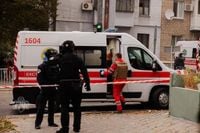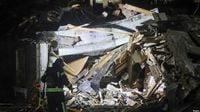September 2025 will be remembered as a month of relentless escalation in Russia’s ongoing aerial campaign against Ukraine, with drone and missile strikes reaching record highs and civilian casualties mounting across multiple regions. According to data analyzed by ABC News, Ukraine’s Air Force reported a staggering 5,636 drones and 187 missiles launched by Russian forces throughout the month—a 38% spike in combined attacks compared to August. The daily average? Nearly 188 drones and just over six missiles, a grim routine that’s become all too familiar for Ukrainian defenders and civilians alike.
The sheer scale of these attacks is sobering. The largest air assault of the war took place on the night of September 6-7, when Russia unleashed 810 drones and 13 missiles in a single night. The result: at least five civilians killed and 41 injured across six Ukrainian regions, including the capital Kyiv, according to the U.N. Human Rights Monitoring Mission in Ukraine. Other major barrages followed on September 19-20 and September 27-28, with 619 and 643 munitions launched, respectively. The United Nations noted that 72% of all civilian casualties in August occurred near the frontlines, primarily in Donetsk and Kherson regions—areas that remain under near-constant threat.
Despite the onslaught, Ukrainian air defenses have managed to intercept or suppress almost 87% of all Russian drones and over 68% of Russian missiles in September, figures that are roughly in line with previous months. Yet, the toll on civilians and infrastructure continues to rise. Neither Russia nor Ukraine publishes detailed data on the scale of their respective strike campaigns, but Ukraine’s Air Force provides a daily tally of Russian drone and missile strikes. Notably, these figures exclude the widespread use of “first person view” drones—commercial quadcopters repurposed as explosive devices—which have become a common sight on the frontlines.
In the closing days of September and into early October, the violence showed no signs of abating. On the night of September 30 to October 1, regional authorities reported that Russian attacks killed at least five civilians and injured 51 more, including children, as detailed by The Kyiv Independent. Russia launched 49 Shahed-type attack drones and decoy drones, as well as four ballistic missiles. Ukrainian air defenses intercepted 44 of these drones, but five missiles and drones struck several locations, causing death and destruction.
The human cost of these attacks is painfully clear. In Chernihiv Oblast, a Russian Iskander missile killed a man, damaged an agricultural enterprise, and destroyed a car. The region’s energy infrastructure was also targeted. In Dnipro, a drone attack on September 30 killed one person and injured at least 31, including two boys aged 10 and 17, and a 17-year-old girl. Donetsk Oblast saw one person killed and two injured in Kostiantynivka, with six more civilians wounded elsewhere. Kharkiv Oblast suffered the loss of a 64-year-old man in the village of Velyka Shapkivka and five injuries in Kharkiv city. Kherson Oblast recorded one death and three injuries, with five high-rise buildings and six houses damaged. Four people were injured in Sumy Oblast due to drone attacks.
Kharkiv, Ukraine’s second-largest city, has become a frequent target. On the night of September 30 to October 1, a Russian guided aerial bomb attack injured six people, five of whom were hospitalized, and sparked fires at the Barabashovo market and several residential buildings, as reported by Reuters. Mayor Ihor Terekhov described the night as "hard for Kharkiv again," noting that the strikes damaged private houses, cars, power lines, and one of the city’s largest shopping areas. More than 2,800 square meters of market pavilions near the Barabashova metro station were set ablaze, and at least eight people—including an 80-year-old woman—were injured. Governor Oleh Synehubov confirmed that three districts of Kharkiv were affected by the attack, which involved both drones and missiles.
The devastation in Kharkiv followed a rare daytime drone attack on Dnipro the previous day, which killed one person and left dozens injured, including children. Ukrainian President Volodymyr Zelenskyy condemned these attacks as "brazen" and renewed calls for stronger international sanctions against Russia. "Such strikes also demonstrate that the world’s sanctions on Russia must hit the aggressor much harder," Zelenskyy wrote, urging Europe to build a collective defense against Russian drones and missiles "so that no country stands alone against this threat."
The international dimension of the conflict grew more pronounced in September, as Russian drones twice crossed into NATO airspace, prompting allied aircraft to shoot down several over Polish territory. According to ABC News, these incidents marked the first time NATO had shot down Russian drones since the start of the full-scale invasion. At least one drone also crossed into Romania but was not shot down. These airspace violations have heightened tensions and prompted urgent discussions among European leaders about security and defense, with Denmark hosting two summits in early October in response to recent drone sightings that disrupted air traffic.
Meanwhile, Ukraine has not remained passive. Kyiv continued its long-range campaign against Russian targets in September, focusing on energy infrastructure. Russia’s Defense Ministry claimed to have downed 2,788 Ukrainian drones during the month—an average of just under 93 per day, a slight increase from August. May 2025, however, remains the high-water mark for Ukrainian drone activity, with Moscow asserting it shot down 3,611 craft at a daily rate of 116.
As the war grinds on into its fourth year, the civilian population continues to bear the brunt. The U.N. mission to Ukraine has repeatedly highlighted the disproportionate impact on those living near the frontlines. Russian officials frame their long-range attacks as targeting military and industrial sites, but the mounting evidence of civilian casualties and damaged residential infrastructure tells a different story. The use of Iranian-designed Shahed drones (referred to by Russia as Gerans), newer jet-powered variants, and decoy drones like the Gerbera, has only intensified the threat to towns and cities.
The violence is compounded by natural disasters. In early October, severe flooding in Odesa and the surrounding region killed at least nine people, including a family of five trapped in their ground-floor apartment, according to the state emergency service and RFE/RL. Rescuers worked through the night to assist residents and pump water out of buildings, while some survivors suffered from hypothermia due to prolonged exposure to floodwaters.
Against this backdrop of destruction, Ukrainian officials and ordinary citizens alike are striving to maintain a sense of normalcy and resilience. "Despite the strikes and destruction, the city stands firm and continues to live," Mayor Terekhov insisted. But with the frequency and intensity of attacks showing no signs of diminishing, the path forward remains fraught with danger and uncertainty for millions of Ukrainians.





